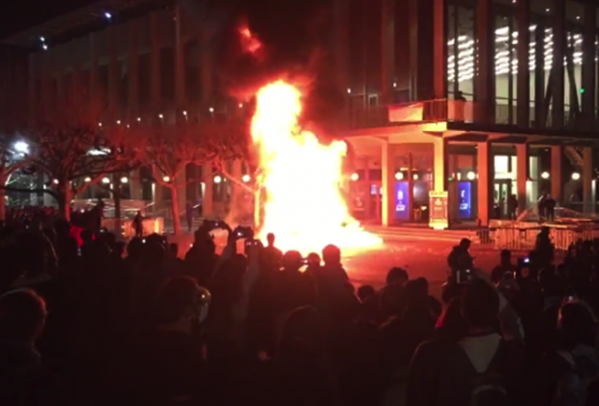 That ain’t no Tea Party… Via Politico:
That ain’t no Tea Party… Via Politico:
House Republicans during a closed-door meeting Tuesday discussed how to protect themselves and their staffs from protesters storming town halls and offices in opposition to repealing Obamacare, sources in the room told Politico.
House GOP Conference Chairwoman Cathy McMorris Rodgers invited Rep. David Reichert, a former county sheriff, to present lawmakers with protective measures they should have in place. Among the suggestions: having a physical exit strategy at town halls, or a backdoor in congressional offices to slip out of, in case demonstrations turn violent; having local police monitor town halls; replacing any glass office-door entrances with heavy doors and deadbolts; and setting up intercoms to ensure those entering congressional offices are there for appointments, not to cause chaos.
“The message was: One, be careful for security purposes. Watch your back. And two, be receptive. Honor the First Amendment, engage, be friendly, be nice,” said Republican Study Committee Chairman Mark Walker (R-N.C.). “Because it is toxic out there right now. Even some of the guys who have been around here a lot longer than I have, have never seen it to this level.”
He later added: “For those of us who have children in grade school and that kind of thing, there’s a factor in all of this, saying: How far will the progressive movement go to try to intimidate us?”
The conference discussion comes as Democratic activists around the nation ramp up protests against Republican efforts to repeal Obamacare.
That’s not a protest. That’s fascism.
Last weekend, conservative Rep. Tom McClintock (R-Calif.) similarly had to be escorted out of a town hall meeting by a half-dozen police officers after the crowd turned angry. And just as Republicans were leaving their conference meeting Tuesday, more than 100 protesters showed up at one of Rep. Martha McSally’s Arizona congressional offices, according to the Arizona Daily Star.
Also discussed at the closed-door conference meeting was how to engage Democratic constituents to ensure they feel they’re being heard. After Reichert (R-Wash.) spoke about the security side, Speaker Paul Ryan (R-Wis.) stood up to talk about how to engage constituents in a “congenial” manner.
Asked about the intensity of the protests during a news conference after the meeting, Ryan said he hopes the demonstrations remain nonviolent.
“Peaceful protests are something we honor in this country,” he said. “I just hope people keep it peaceful.”
Democrats, meanwhile, dismissed Republicans’ security ramp-up as an attempt to shield themselves from criticism.
From the WaPo:
Ronald Reagan, whose approval ratings fell from 51 percent in his first year as president to a meager 34 percent by 1982, was also the focus of international and domestic fury. Reagan triggered an international uproar when he insisted on the deployment of 572 intermediate-range nuclear force missiles in Western Europe, fulfilling a NATO agreement that had been finalized in 1979. When Reagan moved forward this plan, there was an outcry from New York to the streets of Paris. Tens of thousands of moderate and left-wing Europeans demonstrated against these new weapons on the grounds that they would escalate the threat of nuclear war. Within the United States, the nuclear freeze movement ramped up into high gear, warning that this deployment was just one among many things that Reagan had done to bring the world to the brink of nuclear war.
On July 12, 1982, almost a million people came to a protest in New York City to express their support for freezing the production of nuclear weapons and to state their anger about Reagan. “My belief,” said then-Rep. Edward J. Markey (D-Mass.), “is that Reagan was not put on Earth by God to bring us supply side economics. His role is to sit down with Brezhnev and end the arms race, to do for nuclear arms what Nixon did for China. My role is to create the atmospherics, the public and congressional support, that will make Reagan the greatest man who ever lived. He can reject, it, of course, but we will have tried.” The freeze movement drew millions of adherents, while in Congress, the House passed amendments that prohibited the administration from sending any more assistance to anti-communist forces overseas. The protests would continue over the following year, and Reagan’s approval ratings would remain low until 1984 (reaching 41 percent in January 1983). But it wouldn’t matter.
The problem was that Reagan’s support among Republicans kept growing.